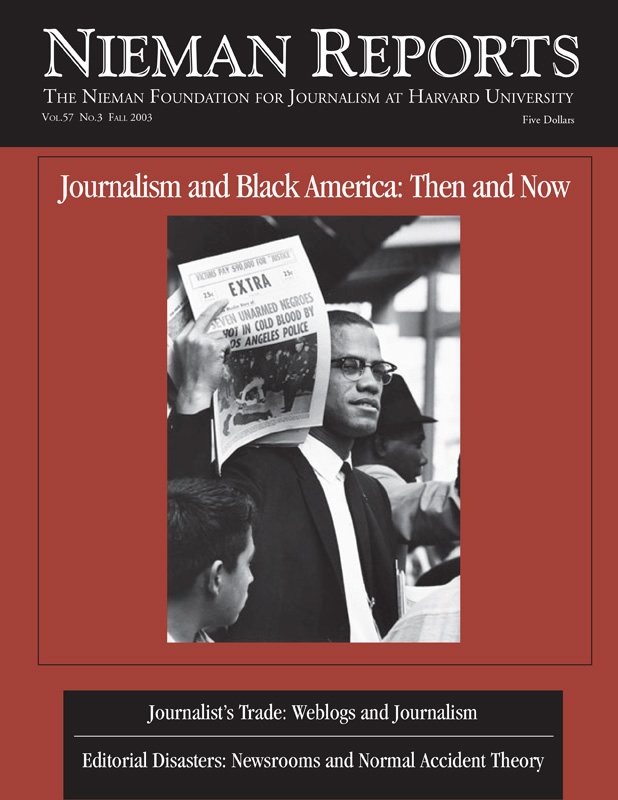Accidents happen in newsrooms, and some even can be expected to happen, according to William F. Woo, a former editor of the St. Louis Post-Dispatch who teaches journalism at Stanford University. Woo connects ideas emerging from Charles Perrow and other scholars of normal accident theory with editorial disasters in newsrooms. Woo begins by asking whether “there is something about news organizations—how they are managed, structured and equipped with technologies—that might offer us an explanation?” In his comprehensive analysis, Woo walks readers through some accidents—both in and out of newsrooms, with particular attention paid to what happened with Jayson Blair at The New York Times—to explore how well various institutions and industries might be able to prevent them. “When we don’t see that newsroom values … can be thought of as operating systems, then we risk finding that our newsrooms have become so complicated that the interaction of everything in them becomes too difficult to track,” Woo writes. “The result: We will not apprehend the next disaster until it is upon us.” In an accompanying box, Woo associates what the Times’s Siegal committee found with what the theories he’s written about tell us, and he observes that “if even a quarter of all the recommendations are put in place, the paper’s complexity will grow and with it the chance not only for things to go wrong but for the problems to spread in unpredictable ways.”
In an essay entitled “While the Watchdogs Slept,” Gilbert Cranberg, the former editor of The Des Moines Register’s editorial pages, wonders why the press hasn’t done a better job of investigating the Bush administration’s stated reasons why the United States went to war in Iraq. “Why did it take some four months from the disclosures by [Mohammed] ElBaradei and [Seymour] Hersh for press and politicians to find their voice and ask tough questions …?”
Alex S. Jones, director of the Joan Shorenstein Center on the Press, Politics and Public Policy at Harvard University, reflects on the life, times and journalism of Scotty Reston, who was Washington bureau chief for The New York Times during the 1950’s and 1960’s. Jones’s thoughts about the ways in which Reston reported on events of his time compared with how reporters in Washington now work were spurred by publication of John F. Stacks’s book, “Scotty: James R. Reston and the Rise and Fall of American Journalism.” Jones observes that, “Scotty Reston emblemized a moral journalism that could be tough or gentle depending on the situation, and he and his peers felt comfortable making those choices based on their sense of what was best for the nation.”
From the apartheid policies of South Africa to the civil unrest that plagued countries in Southern Africa, John Ryan writes about three decades of experience working as a white newspaper reporter covering these stories. Wilson Wanene, a Kenyan-born freelance journalist living in Boston, reviews Ryan’s book, noting the value of “One Man’s Africa” to journalists. “… one gets to see that even under a racially divisive system, there were newspapers and reporters calling things as they were.” Yet there were many stories white journalists couldn’t tell, and Wanene tells us how newspapers “relied on novice black journalists it recruited who in turn performed beyond expectations. Sadly though, they could not be given bylines as this would have endangered them.”
In an essay entitled “While the Watchdogs Slept,” Gilbert Cranberg, the former editor of The Des Moines Register’s editorial pages, wonders why the press hasn’t done a better job of investigating the Bush administration’s stated reasons why the United States went to war in Iraq. “Why did it take some four months from the disclosures by [Mohammed] ElBaradei and [Seymour] Hersh for press and politicians to find their voice and ask tough questions …?”
Alex S. Jones, director of the Joan Shorenstein Center on the Press, Politics and Public Policy at Harvard University, reflects on the life, times and journalism of Scotty Reston, who was Washington bureau chief for The New York Times during the 1950’s and 1960’s. Jones’s thoughts about the ways in which Reston reported on events of his time compared with how reporters in Washington now work were spurred by publication of John F. Stacks’s book, “Scotty: James R. Reston and the Rise and Fall of American Journalism.” Jones observes that, “Scotty Reston emblemized a moral journalism that could be tough or gentle depending on the situation, and he and his peers felt comfortable making those choices based on their sense of what was best for the nation.”
From the apartheid policies of South Africa to the civil unrest that plagued countries in Southern Africa, John Ryan writes about three decades of experience working as a white newspaper reporter covering these stories. Wilson Wanene, a Kenyan-born freelance journalist living in Boston, reviews Ryan’s book, noting the value of “One Man’s Africa” to journalists. “… one gets to see that even under a racially divisive system, there were newspapers and reporters calling things as they were.” Yet there were many stories white journalists couldn’t tell, and Wanene tells us how newspapers “relied on novice black journalists it recruited who in turn performed beyond expectations. Sadly though, they could not be given bylines as this would have endangered them.”



